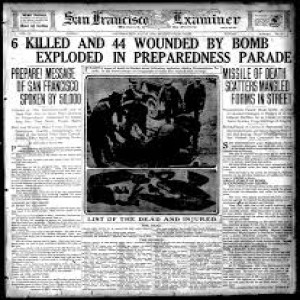
On this day in labor history, the year was 1916.
That was the day a bomb rocked the Preparedness Day parade in San Francisco, killing 10 and injuring at least 40.
The Chamber of Commerce and the newly formed Law and Order Committee organized the parade to shore up support for war production and eventual entry into World War I.
But isolationist sentiment in San Francisco remained strong. Anti-war activists prepared pamphlets and protests for the march.
Many trade unionists were opposed to entry into the war.
Some considered the parade a response to the combative longshoreman’s strike raging on the docks for weeks.
San Francisco had been a strong union town for years, known for strikes and labor disputes.
1916 was an election year and already, the city had been rocked by a number of strikes.
Business interests launched an open shop campaign and began targeting labor radicals.
They found their scapegoats in labor leaders Tom Mooney and Warren Billings, who were framed and convicted for the bombings.
Journalist Carl Nolte points out that Mooney and his assistant had been trying to organize workers at the city’s largest streetcar company, United Railroads.
He notes their convictions were based on perjured testimony and doctored evidence. Incredibly, one of the prosecution’s star witnesses wasn’t even in town that day!
But the convictions served to vilify labor militants as terrorists.
Fremont Older, editor of two local newspapers, discovered the frame-up evidence.
He and many others, including Upton Sinclair and Clarence Darrow campaigned for years to free the two men. They were finally released after 22 years, in 1939.
The actual bombers were never found, though some have speculated that Anarchists of the Galleanist movement were likely responsible.
More Episodes
 2024-08-26
2024-08-26
 2024-08-25
2024-08-25
 2024-08-23
2024-08-23
 2024-08-23
2024-08-23
 2024-08-23
2024-08-23
 2024-08-20
2024-08-20
 2024-08-18
2024-08-18
 2024-08-17
2024-08-17
 2024-08-16
2024-08-16
 2024-08-15
2024-08-15
 2024-08-14
2024-08-14
 2024-08-11
2024-08-11
 2024-08-09
2024-08-09
Create your
podcast in
minutes
- Full-featured podcast site
- Unlimited storage and bandwidth
- Comprehensive podcast stats
- Distribute to Apple Podcasts, Spotify, and more
- Make money with your podcast
It is Free
- Privacy Policy
- Cookie Policy
- Terms of Use
- Consent Preferences
- Copyright © 2015-2024 Podbean.com




